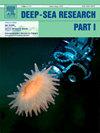Faunal communities of Arctic deep-water methane seeps are specialised with links to hydrothermal vents
IF 2.1
3区 地球科学
Q2 OCEANOGRAPHY
Deep-Sea Research Part I-Oceanographic Research Papers
Pub Date : 2025-09-22
DOI:10.1016/j.dsr.2025.104594
引用次数: 0
Abstract
Cold seeps are common seafloor features on Arctic continental margins, but the cold seep fauna in the region has mainly been characterized from sites on the continental shelf or upper slope (<800 m). Here, we characterize the fauna of two deep-water cold seeps on the Vestnesa (1300 m) and Svyatogor Ridges (1900 m) based on morphological analyses and DNA barcoding. The Svyatogor Ridge system has been hypothesized to represent a hybrid system with processes resembling both hydrothermal vents and cold seeps, however, until now, it had not been tested whether its fauna shows any similarity to regional hydrothermal vent fauna. The present study documents a clearly specialised fauna at both seeps with seven putatively new and seep-specialised species recorded as well as eight species shared with the sedimented hydrothermal vent Loki's Castle approximately 540 km further south on the Mohns Ridge. The dataset presented illustrates a close connection between vent and seep faunas in the Arctic, presumably driven by the close geographic proximity of vents and seeps and the presence of intermediate habitats such as sedimented vents.
北极深水甲烷渗漏的动物群落与热液喷口有关
冷渗是北极大陆边缘地区常见的海底特征,但该地区的冷渗动物群主要分布在大陆架或上斜坡(<800 m)。本文基于形态学分析和DNA条形码,对Vestnesa (1300 m)和Svyatogor山脊(1900 m)两个深水冷渗漏区动物群进行了表征。Svyatogor Ridge系统被假设为一个混合系统,具有类似热液喷口和冷渗漏的过程,然而,到目前为止,还没有测试其动物群是否与区域热液喷口动物群有任何相似性。目前的研究记录了两个渗漏处明显的特殊动物群,其中记录了7种假定的新物种和渗漏专用物种,以及8种与沉积热液喷口Loki’s Castle共有的物种,该喷口位于莫恩斯山脊以南约540公里处。所提供的数据集说明了北极通风口和渗漏动物之间的密切联系,可能是由于通风口和渗漏的地理位置接近以及沉积物通风口等中间栖息地的存在。
本文章由计算机程序翻译,如有差异,请以英文原文为准。
求助全文
约1分钟内获得全文
求助全文
来源期刊
CiteScore
4.60
自引率
4.20%
发文量
144
审稿时长
18.3 weeks
期刊介绍:
Deep-Sea Research Part I: Oceanographic Research Papers is devoted to the publication of the results of original scientific research, including theoretical work of evident oceanographic applicability; and the solution of instrumental or methodological problems with evidence of successful use. The journal is distinguished by its interdisciplinary nature and its breadth, covering the geological, physical, chemical and biological aspects of the ocean and its boundaries with the sea floor and the atmosphere. In addition to regular "Research Papers" and "Instruments and Methods" papers, briefer communications may be published as "Notes". Supplemental matter, such as extensive data tables or graphs and multimedia content, may be published as electronic appendices.

 求助内容:
求助内容: 应助结果提醒方式:
应助结果提醒方式:


